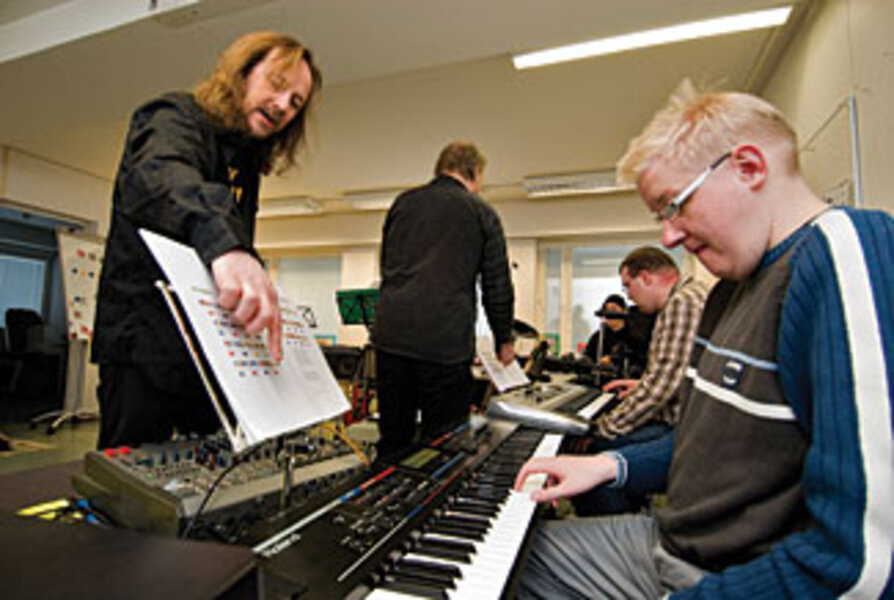Finnish teacher unlocks music for special-needs students
Loading...
| Helsinki, Finland
Jamming on keyboards, bass guitar, and drums, four young men fill a basement room with harmony. The only unusual items here are the colorful squares, triangles, and circles up on a magnet board. The symbols are stand-ins for conventional musical notes – the keys that have unlocked music for the students here.
The Special Music Center Resonaari has a humble, cozy setting – a converted two-story home in Finland's capital. But for the 170 people with intellectual or developmental disabilities who take music classes here each week, it's a place where their talents, not their special needs, take center stage.
For music teacher Markku Kaikkonen, the director, it's also the nucleus of a "cultural revolution."
"Our pupils, many of them, have lived in the margin of society. But now, with the help of ... music education, they are coming closer and closer to the center of society," Mr. Kaikkonen says, leaning forward with excitement, his brown hair hanging loosely about his shoulders.
The effects spread far beyond the students, Kaikkonen says. They change attitudes among families, neighbors, and the audiences who see them perform.
Figurenotes, a system of notation and teaching, has been developed and tested over the past decade by Kaikkonen and codirector Kaarlo Uusitalo. Students learn to play by matching the symbols to keys on a piano or frets on a guitar. Colors indicate notes, shapes show the octave, and arrows show sharps and flats. It's a simple way to convey all the information in traditional notation.
The Figurenotes method has spread to Japan, Estonia, and Scotland.
"What they're teaching us is that people with learning disabilities are capable of doing so much more in terms of their musical ability than what we previously knew," says Brian Cope, artistic director of Drake Music Scotland, a charity that uses Figurenotes in both mainstream and special education.
Students often arrive with no concept of rhythm, melody, or other basics. Some can use only one finger to play. Others are very shy. It can take years to reach the point of performing in annual concerts, which draw hundreds. Kaikkonen and his teachers patiently rejoice in every step of progress.
"In the beginning, it's only colors and symbols, but then suddenly it starts to be music, and it's the miracle moment," Kaikkonen says. "When a person is playing for the first time in his life, and he understands, 'I played music!' ... I call it the big-smile effect." It kicks off a lifelong cycle of learning, he says.
When student Marko Koivu arrived for classes about 10 years ago, he had only two friends: his mother and a nurse. "He was a really passive boy," Kaikkonen recalls.
Before long, Marko was learning to play the keyboard. "His mother called to say, 'Marko is teaching me how to play chords. Are these real chords?' " Kaikkonen says. "It was a great moment ... when the son ... had knowledge about something that the mother didn't know anything about."
Marko started exploring bus routes to rehearsals, instead of relying on his free taxi card. He befriended some famous Finnish musicians, who joined him and other Resonaari students onstage.
"Music is my life," he says. "When we have concerts, it is giving me a good feeling."
Kaikkonen studied music education and music therapy at Helsinki's prestigious Sibelius Academy long before good methods for teaching music to the disabled had been found. But as a teacher at a secondary school and as a music therapist at a mental hospital, he learned to turn chaos into order among students with behavioral problems. And two "master teachers" showed him how to bring out people's hidden talents.
"When working with special-needs people, Markku treats them with respect and humanity, with trust in their potential," writes Ulla Hairo-Lax in an e-mail interview. A music teacher and researcher in Helsinki, she has observed his work and credits him with "boundless 'innovativeness' " and a "hilarious sense of humor."
Kaikkonen joins Marko's band practice, tapping a plaid-slippered foot on a set of bongos on the floor, his hand tucked into a back pocket of his black jeans. Mr. Uusitalo leads the group as they play (and sing in Finnish) John Fogerty's zesty "Proud Mary."
Perhaps they'll perform it at the next concert. The Resonaari players' professionalism, and their ties to the well-known artists who perform with them, are central to Kaikkonen's "cultural revolution."
They challenge people's notions of who can be a musician, he says. "People are coming because the music is so good. For the audience, it is the moment when they start to think [about] the power of these people." Maybe they look a bit different, but what the audience finds isn't a needy person. It's a "person who is as talented as anybody."•






